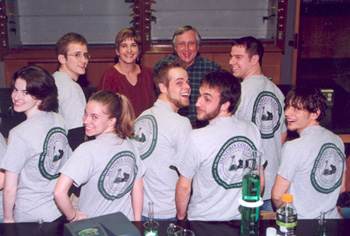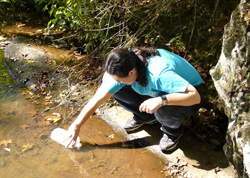
Green chemistry is the design of reactions to reduce or eliminate hazardous materials. Chemists have a growing ability, and responsibility, to tailor chemical reactions to reduce or eliminate wastes. At Hendrix College, we have created a chemistry curriculum that aids our future scientists and citizens in considering the environmental consequences of their actions as they are doing great science. Green chemistry is pollution control at a fundamental level.
It is not what you do as a chemist, but how you do it.
Is your education green?
Unique in the nation, the whole curriculum at the Chemistry Department of Hendrix College has a green sensitivity. Our novel, innovative, green laboratories involve students in the introductory course series of General and Organic Chemistry in learning green ethics. In addition to the curriculum, there is green faculty-sponsored research into the development of green laboratories for the general and introductory organic chemistry programs, investigation of organic solvent replacement technologies, and the study of chemical communication (pheromones) among African elephants, part of the advanced work our student-scholars do.

In the formal curriculum, the general chemistry students participate in the Green-SWAT (Green Soil-Water Analysis at Toad Suck) program while the organic students work with the Toad Suck Institute for Green Organic Chemistry.
Only recycled electrons were used for this Web site. No electrons were created or destroyed in the formation of this site.
Zero Effluent Laboratory:
An Early Experiment in Green Chemistry
In 1973, Brown University graduate student Peter Livant suggested to Assistant Professor Tom Morton the idea of an organic chemistry laboratory in which safety was emphasized, wastes (effluent) were minimized, and solvents were recycled. Dr. Morton was inspired to write a successful proposal to the Exxon Educational Foundation, and this remarkably prescient early effort in green chemistry was implemented with the help of postdoctoral fellows Len Corwin and Ron Roth.
Among other things, students were required to research all of the potential hazards of the chemicals involved before being admitted to lab, and to write a flow chart to account for the fate of every reagent and solvent that they used. The lab was not perfect, and some well-intentioned efforts were later found to be misguided (such as the use of Freon 113 as a primary solvent), nonetheless the project is certainly worthy of study for an historical perspective on this early work. The Zero Effluent Laboratory lab manual is now out of print. However, Professor Morton (University of California, Riverside) gave us permission to post it along with a copy of his talk on the project. Questions about this subject may be directed to him at morton@ucr.edu.